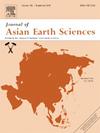Revealing the shallow geometry of the Litang fault on the southeastern Qinghai-Tibet Plateau using multi-frequency ground Penetrating radar (GPR) profiles and trenching
IF 2.7
3区 地球科学
Q2 GEOSCIENCES, MULTIDISCIPLINARY
引用次数: 0
Abstract
Subject to the severe and fragile natural environment on the Qinghai-Tibet Plateau, it was labour-intensive and time-consuming to obtain the detailed shallow geometry of the Litang fault for understanding the fault’s kinematics and characteristics using traditional methods. In this study, we presented a case study to investigate the detailed shallow geometry of the Litang fault using multi-frequency GPR profiles and trenching. The shallow geometry of active faults at variable depth with multi-spatial resolutions was revealed by multi-frequency GPR data. A deformation zone, two faults F1 and F2 and three stratigraphic units were identified in the 100 MHz GPR data, and the detailed subsurface information of the fault F1 was clearly discerned in the 250 MHz and 500 MHz GPR profiles with a better lateral and vertical resolution. In addition, the fault displacement of ∼ 0.2 m was verified in the 500 MHz GPR data through the interfaces of different stratigraphic units at the two flanks of the fault F1. The continuous horizontal radar reflections were bent downward when crossing the fault F1, and it indicated the fault F1 was dominated by the movement of the strike-slip fault with a thrust motion. A trenching section was implemented to provide additional information for better interpreting and understanding the GPR data. This study demonstrated that a combination of multi-frequency GPR profiles and trenching was suitable for depicting the detailed shallow geometry of the Litang fault on the Qinghai-Tibet Plateau, especially the geology conditions were complex or surface evidences were unobservable.
利用多频探地雷达剖面和沟槽揭示青藏高原东南部理塘断裂的浅层几何形态
由于青藏高原恶劣脆弱的自然环境,利用传统方法获取理塘断裂的详细浅层几何形态,了解断裂的运动学和特征,耗费大量人力和时间。在本研究中,我们以理塘断裂为例,利用多频探地雷达剖面和沟槽来研究断裂的详细浅层几何形状。利用多频探地雷达资料揭示了不同深度、多空间分辨率的活动断层浅层几何形态。100 MHz探地雷达剖面识别出1个变形带、F1和F2两条断层和3个地层单元,250 MHz和500 MHz探地雷达剖面清晰地识别出F1断层的详细地下信息,横向和纵向分辨率均较好。此外,通过F1断层两侧不同地层单元的界面,在500 MHz GPR数据中验证了断层位移约0.2 m。在穿越F1断层时,连续的水平雷达反射向下弯曲,表明F1断层以逆冲运动的走滑断层运动为主。为了更好地解释和理解探地雷达数据,还实施了一个挖沟段。研究结果表明,在地质条件复杂或地表证据不足的情况下,多频探地雷达剖面与沟槽相结合的方法适合描绘青藏高原理塘断裂的详细浅层几何形态。
本文章由计算机程序翻译,如有差异,请以英文原文为准。
求助全文
约1分钟内获得全文
求助全文
来源期刊

Journal of Asian Earth Sciences
地学-地球科学综合
CiteScore
5.90
自引率
10.00%
发文量
324
审稿时长
71 days
期刊介绍:
Journal of Asian Earth Sciences has an open access mirror journal Journal of Asian Earth Sciences: X, sharing the same aims and scope, editorial team, submission system and rigorous peer review.
The Journal of Asian Earth Sciences is an international interdisciplinary journal devoted to all aspects of research related to the solid Earth Sciences of Asia. The Journal publishes high quality, peer-reviewed scientific papers on the regional geology, tectonics, geochemistry and geophysics of Asia. It will be devoted primarily to research papers but short communications relating to new developments of broad interest, reviews and book reviews will also be included. Papers must have international appeal and should present work of more than local significance.
The scope includes deep processes of the Asian continent and its adjacent oceans; seismology and earthquakes; orogeny, magmatism, metamorphism and volcanism; growth, deformation and destruction of the Asian crust; crust-mantle interaction; evolution of life (early life, biostratigraphy, biogeography and mass-extinction); fluids, fluxes and reservoirs of mineral and energy resources; surface processes (weathering, erosion, transport and deposition of sediments) and resulting geomorphology; and the response of the Earth to global climate change as viewed within the Asian continent and surrounding oceans.
 求助内容:
求助内容: 应助结果提醒方式:
应助结果提醒方式:


